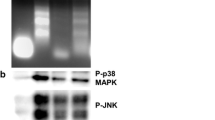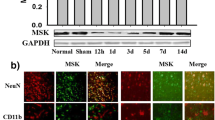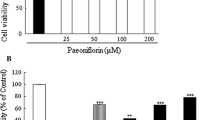Abstract
We studied the effects of Semax (antiinsulin peptide with neuroprotective effect) on the survival of cultured rat pheochromocytoma cell after oxidative stress induced by short-term incubation with hydrogen peroxide. Studies with fluorescent dyes propidium iodide and Hoechst 33258 showed that cell incubation with hydrogen peroxide led to the formation of damaged cells with characteristic signs of necrosis. Semax dose-dependently reduced the number of cells damaged by oxidative stress. The efficiency of Semax depended on the time of its addition to the culture medium. The results suggest that the neuroprotective effect of Semax in ischemic stroke can be due to its capacity to protect neurons from damage caused by oxidative stress.
Similar content being viewed by others

REFERENCES
I. P. Ashmarin, V. N. Nezavibat'ko, N. F. Myasoedov, et al., Zh. Vyssh. Nervn. Deyat., 47,No. 2, 420–430 (1997).
I. A. Grivennikov, O. V. Dolotov, and Yu. I. Gol'dina, Mol. Biol., 33,No. 1, 120–126 (1999).
E. I. Gusev and V. I. Skvortsova, Brain Ischemia [in Russian], Moscow (2001).
E. I. Gusev, V. I. Skvortsova, N. F. Myasoedov, et al., Zh. Nevrol. Psikhiatr., No. 6, 26–34 (1997).
O. V. Dolotov, L. S. Inozemtseva, L. A. Andreeva, et al., “Prospects of Physicochemical Biology”, Proceedings of Workshop [in Russian], Pushchino (2000), vol. 1, p. 236.
A. Ya. Kaplan, V. B. Koshelev, and V. N. Nezavibat'ko, Fiziol. Chel., 18,No. 5, 104–107 (1992).
N. F. Myasoedov, V. I. Skvortsova, E. L. Nasonov, et al., Zh. Nevrol. Psikhiatr., No. 5, 15–19 (1997).
E. R. Safarova, S. I. Shram, I. A. Grivennikov, and N. F. Myasoedov, Byull. Eksp. Biol. Med., 133,No. 4, 462–465 (2002).
V. G. Bashkatova, V. B. Koshelev, O. E. Fadyukova, et al., Brain Res., 894,No. 1, 145–149 (2001).
D. B. Hinshaw, M. T. Miller, G. M. Omann, et al., Ibid., 615,No. 1, 13–26 (1993).
P. Lipton, Physiol. Rev., 79,No. 4, 1431–1568 (1999).
S. Love, Brain Pathol., 9,No. 1, 119–131 (1999).
V. N. Potaman, L. Y. Alfeeva, A. A. Kamensky, and V. N. Nezavibatko, Peptides, 14,No. 3, 491–495 (1993).
M. I. Shadrina, O. V. Dolotov, I. A. Grivennikov, et al., Neurosci. Lett., 308,No. 2, 115–118 (2001).
Author information
Authors and Affiliations
Rights and permissions
About this article
Cite this article
Safarova, E.R., Shram, S.I., Zolotarev, Y.A. et al. Effect of Semax Peptide on Survival of Cultured Rat Pheochromocytoma Cells during Oxidative Stress. Bulletin of Experimental Biology and Medicine 135, 268–271 (2003). https://doi.org/10.1023/A:1024141232307
Issue Date:
DOI: https://doi.org/10.1023/A:1024141232307



